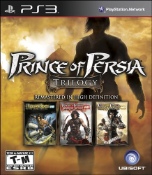Prince of Persia Trilogy Review
|
|
See PixlBit's Review Policies

On 06/21/2011 at 09:22 PM by Nick DiMola The graphics haven’t particularly aged well, but boy are the games still great. |

A must-buy for fans of action or platforming games that haven’t already had a chance to experience the Sands trilogy. This is a no-brainer for fans of the Assassin’s Creed series. Those who already have each of the games won’t be getting much from this compiled remastering.
It’s mind-blowing to think it has been eight years since the original release of Prince of Persia: The Sands of Time; at the time, the game was ground-breaking in its unique approach to platforming, combat and its signature time-reversing mechanic. While it feels like the game was released just yesterday, it’s getting old and it’s absolutely showing its age – even with the slight graphical improvement featured in this remastered compilation.

Having not revisited any of the games in the Sands of Time trilogy since playing them around their respective releases, it’s surprising to see just how much of an influence they had on the design of Assassin’s Creed. Unfortunately for those who have played Ubisoft’s latest series, stepping back into the Sands trilogy can be a bit jarring as both the platforming and combat aren’t nearly as polished. That being said, they still hold some definite appeal and are absolutely worth a play through if you haven’t already.
Booting up the game, you won’t be imparted with much confidence by the slapdash presentation. The game boots into a simple selection screen that looks like it was thrown together in a matter of minutes. After choosing one of the titles – The Sands of Time, Warrior Within and The Two Thrones – you are booted directly into the selected game’s original menu. If you so desire to switch to another game, you’ll be forced to reboot. It’s not awful, but it just goes to show that little effort has been invested. The Trilogy should’ve celebrated the characters, art, and lore of the series, but instead seeks to merely deliver the promised titles.

Things do improve upon starting any of the given games. With HD-upscaled graphics, the games are now devoid of any jagged edges and everything looks much crisper. However, everything still looks quite boxy as most of the content hasn’t been changed for the release. Having played The Sands of Time on the computer, I didn’t see a real improvement in the presentation. It’s possible that the addition of 3D has a more staggering effect, but without a 3D TV it’s hard to say. While the games do look better, they are hardly the remakes Ubisoft has labeled them as.
Of course, the real attraction of this package is having the entire Sands trilogy at the tips of your fingers. If you haven’t experienced any of the games before, the gameplay premise is simple, but unique and hasn’t been replicated to date. The titular prince possesses two unique abilities that shape the experience. The first is an unbelievable amount of dexterity and coordination, which allows him to gymnastically traverse the torn and tattered landscapes, swinging, climbing, and running along walls to avoid pitfalls and deadly traps. These gymnastic abilities extend into fighting as well, where the Prince will dispatch multiple enemies at a time with great ease.

His second ability in conjunction with the first is what makes this particular trilogy so enjoyable. Through use of the Sands of Time, the Prince can turn back the clock and “rewind” a failed action to a previous state of operation, allowing for a redo of a given segment. With a limited number of rewinds, players need to take care to properly traverse the landscape to avoid permanent death. Thankfully, through use of a special dagger, the Prince can refill the sands by defeating enemies and impaling them.
With the immediate threat of death removed, players are encouraged to be daring and careless with their gymnastic platforming. Of course, death is still looming if absolutely no caution is executed, but players will quickly learn their limits and understand how to properly push them to achieve the greatest level of success.

The gymnastics and agile combat have been carried into the Assassin’s Creed series, making them feel somewhat dated here, but given the fact that the Prince is more agile than both Altair and Ezio, combat is a touch different and a bit more dynamic. The Prince can hop over enemies, run on walls, and perform various other attacks that are all smooth to execute and impressive to watch.
All three of the games are based around these general maneuvers, though I found The Sands of Time to be the best of the bunch. Warrior Within was slightly heavier on combat, and the darker, more aggressive Prince made for a less likable protagonist. The Two Thrones added the gimmick of the Dark Prince, which made for some more interesting combat and plot, but didn’t drastically alter the general experience seen in the two preceding titles.

It has been a while since I played the original versions of each game and as such I can’t recall any glaring flaws or bugs, but here I had encountered them intermittently, specifically during combat. While somersaulting over enemies, I found that the game would occasionally glitch, causing me to miss an attack or to get caught in the level’s walls and edges. None of the bugs crashed or broke the game but were definitely frustrating. It’s especially shameful to see them in what should be the definitive package of the series.
All issues aside, each game is solid, offering around 15-20 hours of gameplay – an incredible overall value, especially at its value price. While the visuals haven’t aged particularly well, the gameplay still holds up despite being outdone by the succeeding Assassin’s Creed series. Fans of action games and platforming can’t go wrong with this exceptional trilogy.










Comments